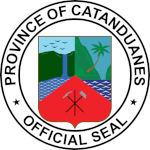Foundation Day of Catanduanes in the Philippines Date in the current year: October 26, 2026
 The Foundation Day of Catanduanes (Araw ng Pagkakatatag ng Catanduanes) is a special non-working holiday in the Philippine province of Catanduanes that commemorates its separation from the province of Albay. It is celebrated annually on October 26.
The Foundation Day of Catanduanes (Araw ng Pagkakatatag ng Catanduanes) is a special non-working holiday in the Philippine province of Catanduanes that commemorates its separation from the province of Albay. It is celebrated annually on October 26.The province of Catanduanes comprises the eponymous island and a number of smaller islands in the Bicol Region of the Philippines. The earliest recorded names of the province’s main island was Isla de Cobos, given to it by Spanish conquistadors upon their arrival in 1573. Cobos was the local name for thatched huts where the indigenous tribal people lived.
The name Catanduanes is believed to derive from one of the two local words: tandu or samdong; the former is a native beetle, and the latter is a native tree species. One version of the name’s origin claims the locals referred to their island as katanduan, “a place where the tandu beetle is abound”. Another version says they called the island kasamdongan, “a place where the samdong tree thrive in abundance”. Catanduanes is thought to be the hispanicized version of one of these two names.
Finally, a third version claims the name derives from a Malay word meaning “a place of refuge” since mariners indeed used to find refuge on the island during stormy weather.
The first people to settle on the island of Catanduanes were descendants of migrants from Borneo who settled on the island of Panay. Sadly, little is known about the early history of Catanduanes due to frequent Moro raids, which resulted in the destruction of most historical evidence dating back to the pre-Spanish period.
The first Europeans to set foot on the island were a group of Spanish conquistadors led by Juan de Salcedo in 1573. Two decades after Salcedo’s arrival, the Spanish brought Franciscan missionaries to Catanduanes to evangelize the locals. The missionaries did not meet much resistance and soon converted the entire population of the island to Christianity.
During the Spanish era, Catanduanes was governed by a delegate commissioner from the neighboring province of Albay. Following the American occupation of the Philippines, Catanduanes was temporarily made a sub-province of Ambos Camarines. However, the province of Ambos Camarines was split into Camarines Norte and Camarines Sur in 1919, and Catanduanes was subsequently annexed to Albay.
During World War II, Catanduanes, along with the rest of the Philippines, was occupied by Imperial Japan. Following the end of the occupation and the independence of the Philippines, it finally became a separate province. The separation of Catanduanes from Albay and its establishment as an independent province was confirmed by the Congress on September 26, 1945, signed into law by the country’s president on October 24, and went into effect on October 26.
In 2022, Catanduanes was officially designated as the Abacá Capital of the Philippines. Abacá (Manila hemp) is a banana species endemic to the Philippines that has great economic importance due to its fiber that is used in textile production; Catanduanes is the top producer of abacá in the Philippines.
- Category
- Anniversaries and Memorial Days
- Country
- Philippines
- Tags
- Foundation Day of Catanduanes in the Philippines, holidays in the Philippines, regional observances, special non-working holiday